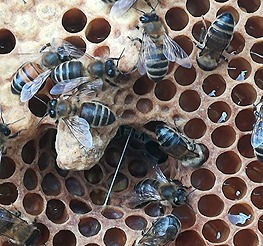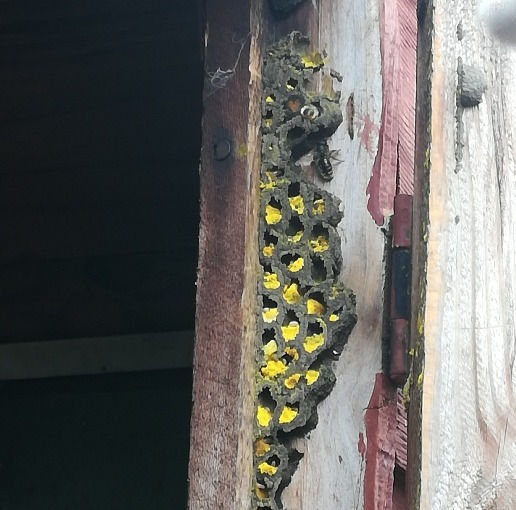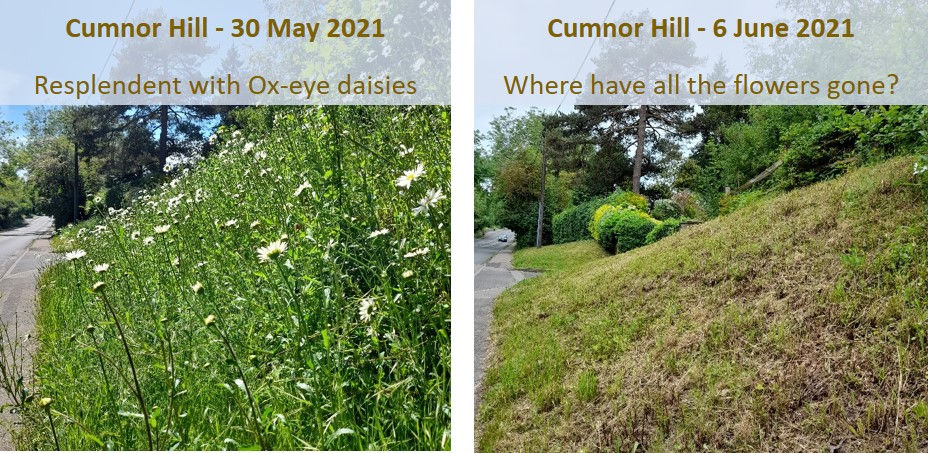Apiary Diary - June 2021
- botleymeadowbees
- Jul 8, 2021
- 4 min read
Updated: Oct 25, 2024
Managing new split colonies - June swarm collections - An unusual bee rescue - Callouts and conversions - Bee identification - Verge of destruction?

Managing our new split colonies
This year’s splits are developing, filling their more capacious accommodation. ‘Splits’ are formed when dividing an established colony to produce one or two new ones (see Time to divide hives, May 2021).

One of our splits failed to produce a laying queen, spelling the hive’s certain demise. So I gave it a further frame of brood (bee eggs and larvae), courtesy of the original 'parent' hive.
This did the trick: the adult worker bees selected an egg to raise as their new queen, which hatched, mated and was laying her own eggs after about three weeks. The colony’s survival was assured!
June swarm collections
We recently collected a more local swarms—one just off the Eynsham Road, and the other from our own garden! Both are now in the garden apiary, to become established over the summer.
The first was from a callout (we are on the local swarm collectors list). The swarm was at an easy height, but in a hedge, which meant cutting out small branches and sprigs before placing them, with as many bees still attached as possible, into our swarm box. It is essential to get the queen inside, as she will attract any remaining bees (conversely, any bees placed inside the box would fly back to her if she were left outside).
The spectacle drew a small crowd of interested onlookers (and perhaps one or two future beekeepers?). It was a pleasure chatting with folk about the bees and what we were trying to do with them. The swarm was re-homed in the apiary before sunset, and they seem a fairly docile colony.

The garden swarm was attracted to some spare beekeeping equipment sitting on the patio, which obviously looked and smelt right to the bees! These were then transferred to the main apiary. We can’t be sure whether they came from our own apiary (no colonies appeared to be depleted), or from outside, but they are very welcome!
An unusual bee rescue
The strangest collection of the season was from an underground fire hydrant! This was at the Fairacres Trading Estate on the edge of Abingdon.
Apparently, bees had been flying in and out of it for about six weeks, when one night some curious person managed to pull up the hydrant cover, to which had been attached about seven large combs. When I arrived, most of these were lying horizontally on the pavement, like a stack of thick pancakes, and were covered with bees keeping the brood warm. One comb and some bees remained deep in the hydrant cavity (possibly with the queen, though she was probably with the main cluster). A downpour was forecast, so their prospects did not look too promising.
I managed to get all of the bees (except a few flyers) into my swarm box, plus the comb (including the piece lodged in the cavity). The comb held not only the colony's food stores, but also its eggs, larvae and unhatched bees. To lose it would have spelt disaster.
That evening I re-hived them, assembling most of their recovered comb in frames, and securing it with grids of elastic bands (Heath-Robinson meets Frankenstein!). The colony is gradually rebuilding the comb—and jettisoning an elastic band outside the hive entrance every few days!
While it’s unusual to find honeybees underground, colonies based in tree cavities near ground level are known to extend comb into pre-hollowed-out root systems; and some colonies have been reported in man-made cavities that house electrical equipment and the like.
Callouts and conversions
As swarm-catchers, we are sometimes called by people who believe they have a honeybee swarm, which turns out to be something else—usually bumble bees or solitary bees (we can only deal with honey bees, but will ask members of the public to treat all bees and other pollinators sympathetically).

One caller, reporting comb-building in their allotment shed, turned out to be hosting mason bees, which use mud to make their nest; only honeybees can produce wax.
Another local resident was worried about a ‘swarm’ around the bird-box on their house. A swarm was highly unlikely—bird-boxes are too small for honeybee colonies, but ideal for bumble bee nests.
After an email or two, her video showed these to be bumble bee drones attracted to a virgin queen bumble bee inside the bird-box. The lady initially wanted to remove them, but became fascinated after observing them (sound familiar?)—another api-convert, I think!
A week or two later a gentleman phoned about an 'annoying swarm' in his garage, and should he pour boiling water on it? Certainly not! From his description, this was another a bumble bee nest, and should be left alone—it will die out in the autumn, and next year’s queen will seek out a new spot. Bumble bees generally won’t sting unless provoked (this poor chap had been stung, but he probably provoked them, now knew better, and agreed to ‘let things bee!’
Useful websites for bee and pollinator identification: OKBA , ONBG and the Bumblebee Conservation Trust.
Verge of destruction?

Last month I posted a picture of a beautiful roadside verge of ox-eye daisies and other wildflowers on Cumnor Hill, praising it as an exemplar of eco-friendly highways management. Within a week it had been mown down: if there was some good reason, I cannot fathom it.
Meanwhile the fantastic movement to support wildflower ‘corridors' is growing. Oxford City Council has plans to review 'grass mowing policies in order to re-wild our highway verges wherever possible', and OCC Councillors have asked Oxfordshire County Council for a review of grass cutting regimes in order to encourage wildlife. If you agree, please lobby your local representatives!
Mark, Botley Meadow Bees, 30 June 2021










Comments